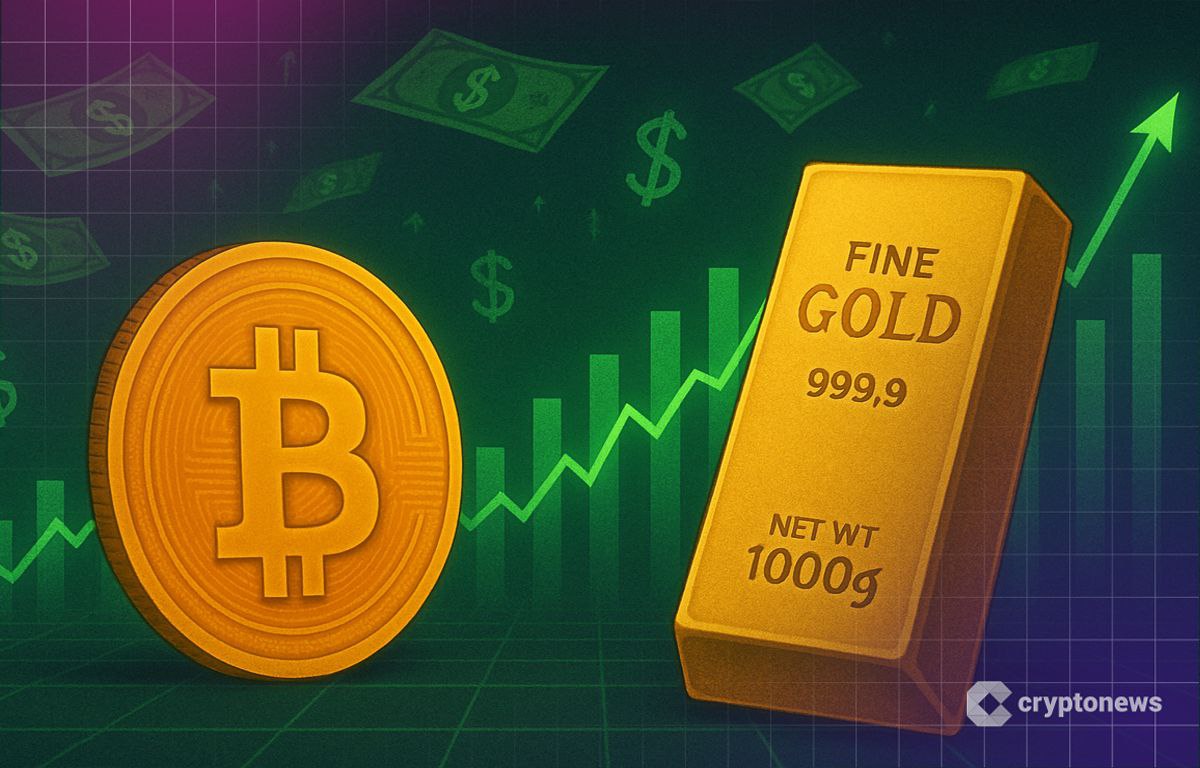Is Bitcoin Finally Decoupling from Stocks and Following Gold?

Key Takeaways:
Bitcoin has “clearly separated” from the S&P 500 and Nasdaq Composite over the last two weeks, according to latest data. The data shows that cryptocurrency is becoming more correlated to gold. But there have been many false flags in the past, which have kept BTC’s reputation as a gold-like store of value in question.Bitcoin (BTC) has broken away from U.S. stock markets in the past two weeks, reigniting debate about whether the cryptocurrency is finally stepping into its long-promised role as the digital equivalent of gold, a safe-haven asset.
The price of Bitcoin has tended to track the stock market during periods of market uncertainty, raising doubts about its suitability as a store of value.
The asset is particularly tied to blue-chip tech stocks like Apple, Nvidia, Meta, and others, in part spurred by institutional adoption following the approval of spot Bitcoin exchange-traded funds (ETFs) in January 2024.
But that is starting to change. According to new data from research firm CryptoQuant, Bitcoin’s correlation with the S&P 500 reached 0.88 in late 2024, but has since dropped to 0.77.
Likewise, its correlation with the tech-heavy Nasdaq Composite peaked at 0.91 in January this year but has now slipped to 0.83, meaning that Bitcoin is now seeing increasing demand as a safe-haven asset.
In a recent report, CryptoQuant said:
“Bitcoin has clearly separated from [U.S. stock market indices], indicating weakening correlation to traditional and technology-related stocks.”
BTC Breaks Away from Stocks
The decoupling is more than just a statistical curiosity. It shows that investors are steadily rotating capital out of stocks into Bitcoin as a hedge against mounting macroeconomic and trade policy risks for U.S. shares.
For example, as of this writing, the price of Bitcoin is up about 1% to $95,000 year-to-date while the Nasdaq has declined nearly 10% during the same period, per Google Finance.
Bitcoin has soared 25% since the multi-month lows of April 7, days after Donald Trump announced his so-called reciprocal tariffs. Meanwhile, the Nasdaq largely remained flat over the same period.
And following the recent adjustments to U.S. tariffs, the latest jobs data, and Trump’s criticism of Federal Reserve chair Jerome Powell, Bitcoin not only held its ground but surged by 7% on April 22, as stocks slumped.
Chipmaker Nvidia, in particular, took a $5.5 billion charge after Trump announced an unprecedented 145% tariff on Chinese imports, setting off a major sell-off across top U.S. technology stocks.
Tracy Jin, chief operating officer of crypto exchange MEXC, highlighted a few factors that have helped speed up Bitcoin’s decoupling, boosting its profile as an alternative safe haven to gold.
Speaking to Cryptonews, Jin said:
“The bigger picture hasn’t changed – it’s getting clearer. The Bitcoin narrative as a ‘macro hedge’ isn’t just talk anymore. It’s showing up in behavior. A falling U.S. Dollar Index [DIY], uncertain Fed signals, and ongoing tariff headlines are creating the kind of backdrop where non-sovereign assets shine.”
Bitcoin’s claim to safety largely rests on its relative performance against different fiat currencies around the world. In the case of the U.S. dollar, BTC goes up when the dollar falls, and vice versa. And the greenback has been weakening.
The DIY, which measures the U.S. dollar against six major foreign currencies, has dropped to 97, its lowest level since 2022. The index has also been down 11% since Trump took office.
Bitcoin Behaving More Like Gold
As the data from CryptoQuant shows, Bitcoin is starting to behave more like gold, which crossed $3,500 for the first time on April 22. Gold prices are up 26% so far this year, outperforming the S&P, which has fallen 6%.
Since the beginning of April, Bitcoin’s correlation with gold has risen from a negative 0.62 coefficient to a negative 0.31 as of April 28.
Source: CryptoQuantWhile the latest gold/Bitcoin negative values represent weak correlations, they are an improvement from a year ago, experts say. A positive reading would mean that the assets are moving in lockstep.
Jin, the MEXC chief operating officer, sees the improving correlation as more than just another fleeting moment, telling Cryptonews:
“This is the start of a structural shift, not just another moment of relative strength. If Bitcoin can hold its ground while equities slide, it might finally step into the role many assigned to it years ago – not just digital gold, but an independent asset class.”
The correlation coefficient measures the relative performance of gold and Bitcoin. Over the past two years, Bitcoin’s correlation with gold has remained “fairly weak,” according to previous data from Kaiko Research.
Gold and Bitcoin are both characterized by their scarcity. Bitcoin’s pseudonymous founder, Satoshi Nakamoto, wired a hard cap of 21 million coins into the world’s biggest cryptocurrency protocol.
Estimates suggest that a total of 213,000 tons of gold have been mined throughout history. Experts say Bitcoin’s finite supply and decentralized structure have led to its perception as a store of value and medium of exchange.
Whereas fiat shares the quality of scarcity with the two asset classes, central banks can print more money as governments direct.
On the other hand, Bitcoin has no central issuing authority. Safeguards like halving theoretically ensure a stable population of coins after the cap is reached.
In practical use terms, investors use Bitcoin and gold as a hedge against inflation and, as noted this April, against trade policy risks, too.
Both asset classes tend to appreciate when traditional markets are hit with uncertainty, though BTC shows a couple of months lag. In April, gold reached record territory and Bitcoin rallied alongside it, as stocks tanked.
This was true of the Covid-19 era, too, when gold hit a then-record of $1,902 per ounce in 2020, while BTC closed in on $29,000. Government-issued fiat currencies struggled in the same period because of stimulus activity.
Institutional Adoption
Gold has seen record demand since the pandemic. According to the World Gold Council, central banks added 1,086 tons of gold in 2024, triple the amount of gold they bought in 2020, of about 254 tons.
The buying continued during the first four months of 2025, pushing the spot price of gold to a record of $3,500 in April. Since its October 2022 lows, gold has returned 102%, almost double the S&P 500’s gain of 54%.
Gold supply and annual supply and demand. Source: World Gold CouncilBitcoin is also seeing massive institutional demand, with record inflows into BTC exchange-traded funds. Large Bitcoin holders known as ‘whales’ have been accumulating huge amounts of the top cryptocurrency.
As Tracy Jin, the MEXC exchange COO, notes, the number of BTC wallets sending assets to exchanges is at a three-year low. The 30-day moving average is down to 52,000 addresses versus 71,000 on the 365-day view.
“Fewer coins moving to exchanges means less sell pressure,” Jin told Cryptonews, adding:
“That kind of supply dynamic, combined with heavy institutional demand, sets up conditions for a potential decoupling – something Bitcoin has flirted with before, but never quite sustained.”
On April 22, U.S.-listed Bitcoin ETFs recorded $936 million in net inflows, the third-highest this year, according to data from Sosovalue. In just 3 days, investors pumped $1.4 billion into more than a dozen funds, led by BlackRock’s iShares Bitcoin Trust (IBIT).
The ETFs have attracted more than $39 billion in new money since their launch in January 2024, as institutional investors seek diversification and a hedge against macroeconomic uncertainty.
Analysts say growing institutional adoption is helping Bitcoin’s market structure to mature, while liquidity is also seeing a boost.
However, the jury is still out on whether Bitcoin lives up to its billing as digital gold in the long term. The digital asset has struggled to break free from risky assets like stocks in the past.
For example, BTC underperformed gold during the Aug. 5, 2024 stock market sell-off, crashing 16%. At the time, BTC fell below $50,000, a rate of decline not seen since the 2022 collapse of FTX and Terraform Labs.
Gold showed more resistance, retreating just over 1%, before erasing those losses by the end of the day.
The post Is Bitcoin Finally Decoupling from Stocks and Following Gold? appeared first on Cryptonews.



